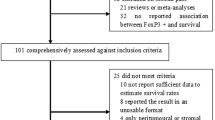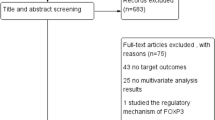Abstract
The aim of this study was to investigate the correlation between tumor-infiltrating CD4+ CD25high Foxp3+ naturally occurring regulatory T cells (Foxp3+ nTregs) and cyclooxygenase-2 (COX-2) expression and their association with local recurrence in resected head and neck cancers. Intratumoral COX-2 and Foxp3+ nTregs expressions were retrospectively assessed using immunohistochemistry. Associations between the clinicopathological characteristics and either intratumoral COX-2 expression or number of Foxp3+ nTregs were tested using the Chi-square test. The correlation between the number of Foxp3+ nTregs and COX-2 expression was tested using Spearman’s rank correlation test. Associations between recurrence-free survival (RFS) and either intratumoral COX-2 expression or number of Foxp3+ nTregs were calculated using the Kaplan–Meier method, and factors that may influence the RFS were analyzed by Cox regression. The five-year RFS for all patients was 35.09%. Patient clinicopathological characteristics had no relationship with intratumoral COX-2 expression or the number of Foxp3+ nTregs. However, a positive correlation between intratumoral COX-2 expression and the number of Foxp3+ nTregs was observed (P < 0.001). The RFS of patients with elevated COX-2 expression was significantly worse than that of patients without intratumoral COX-2 expression (P = 0.0228). The RFS of patients with tumors containing >6 Foxp3+ cells was significantly worse than that of patients with tumors containing ≤6 Foxp3+ cells (P = 0.0020). However, by Cox regression analysis, the RFS of all patients was not influenced by intratumoral COX-2 expression (P = 0.100) or the number of Foxp3+ nTregs (P = 0.071). Tumor-infiltrating CD4+ CD25high Foxp3+ nTregs were positively correlated with intratumoral COX-2 expression and were associated with a worse RFS in univariate analysis.





Similar content being viewed by others
References
Fosslien E. Molecular pathology of cyclooxygenase-2 in neoplasia. Ann Clin Lab Sci. 2000;30:3–21.
Lang S, Zeidler R. Immune restoration in head and neck cancer patients via cyclooxygenase inhibition: an update. Int J Immunopathol Pharmacol. 2003;16(2):41–8.
Baratelli F, et al. Prostaglandin E2 induces Foxp3 gene expression and T regulatory cell function in human CD4+ T cells. J Immunol. 2005;175:1483–9.
Hiraoka N, Onozato K, KosugeT HirohashiS. Prevalence of Foxp3+ regulatory T cells increases during the progression of pancreatic ductal adenocarcinoma and its premalignant lesions. Clin Cancer Res. 2006;12:5423–34.
Curiel TJ, et al. Specific recruitment of regulatory T cells in ovarian carcinoma fosters immune privilege and predicts reduced survival. Nat Med. 2004;10:942–9.
Shimizu K, et al. Tumor-infiltrating Foxp3+ regulatory T cells are correlated with cyclooxygenase-2 expression and are associated with recurrence in resected non-small cell lung cancer. J Thorac Oncol. 2010;5(5):585–90.
Jonuleit H, et al. Identification and functional characterization of human CD4+ CD25+ T cells with regulatory properties isolated from peripheral blood. J Exp Med. 2001;193:1285–94.
Baecher-Allan C, Viglietta V, Hafler DA. Human CD4+ CD25+ regulatory T cells. Semin Immunol. 2004;16:89–98.
Baecher-Allan C, Wolf E, Hafler DA. MHC class II expression identifies functionally distinct human regulatory T cells. J Immunol. 2006;176:4622–31.
Ito T, et al. Two functional subsets of Foxp3+ regulatory T cells in human thymus and periphery. Immunity. 2008;28:870–80.
Curiel TJ. Regulatory T cells and treatment of cancer. Curr Opin Immunol. 2008;20:241–6.
Wang HY, Wang RF. Regulatory T cells and cancer. Curr Opin Immunol. 2007;19:217–23.
Ling KL, et al. Increased frequency of regulatory T cells in peripheral blood and tumour-infiltrating lymphocytes in colorectal cancer patients. Cancer Immun. 2007;7:7.
Beyer M, Schultze JL. Regulatory T cells in cancer. Blood. 2006;108:804–11.
O’Mahony CA, et al. Cyclooxygenase-2 alters transforming growth factor-beta 1 response during intestinal tumorigenesis. Surgery. 1999;126(2):364–70.
Shirahama T. Cyclooxygenase-2 expression is up-regulated in transitional cell carcinoma and its preneoplastic lesions in the human urinary bladder. Clin Cancer Res. 2000;6:2424–30.
Dannenberg AJ, et al. Cyclooxygenase 2: a pharmacological target for the prevention of cancer. Lancet Oncol. 2001;2:544–51.
Chan G, et al. Cyclooxygenase-2 expression is up-regulated in squamous cell carcinoma of the head and neck. Cancer Res. 1999;59:991–4.
Saba NF, et al. Role of COX-2 in tumor progression and survival of head and neck squamous cell carcinoma. Cancer Prev Res (Phila). 2009;2(9):823–9.
Kyzas PA, Stefanou D, Agnantis NJ. COX-2 expression correlates with VEGF-C and lymph node metastases in patients with head and neck squamous cell carcinoma. Mod Pathol. 2005;18(1):153–60.
Chang BW, et al. Prognostic significance of cyclooxygenase-2 in oropharyngeal squamous cell carcinoma. Clin Cancer Res. 2004;10(5):1678–84.
Sharma S, et al. Tumor cyclooxygenase-2/prostaglandin E2-dependent promotion of Foxp3 expression and CD4+ CD25+ T regulatory cell activities in lung cancer. Cancer Res. 2005;65:5211–20.
Huang M, et al. Non-small cell lung cancer cyclooxygenase-2-dependent regulation of cytokine balance in lymphocytes and macrophages: upregulation of interleukin 10 and down-regulation of interleukin 12 production. Cancer Res. 1998;58:1208–16.
Gately S, Li WW. Multiple role of COX-2 in tumor angiogenesis: a target for antiangiogenic therapy. Semin Oncol. 2004;31:2–11.
Costa C, et al. Cyclooxygenase-2 expression is associated with angiogenesis and lymph node metastasis in human breast cancer. J Clin Pathol. 2002;55:429–534.
Lin MT, Lee RC, Yang PC, Ho FM, Kuo ML. Cyclooxygenase-2 inducing Mcl-1-dependent survival mechanism in human lung adenocarcinoma CL1.0 cells. J Biol Chem. 2001;276(52):48997–9002.
Sorokin A. Cyclooxygenase-2: potential role in regulation of drug efflux and multidrug resistance phenotype. Curr Pharm Des. 2004;10:647–57.
Yang L, et al. Cancer-associated immunodeficiency and dendritic cell abnormalities mediated by the prostaglandin EP2 receptor. J Clin Invest. 2003;111:727–35.
Sharma S, et al. Tumor cyclooxygenase 2-dependent suppression of dendritic cell function. Clin Cancer Res. 2003;9:961–8.
Li JF, Chu YW, Wang GM. The prognostic value of peritumonal regulatory T cells and its correlation with intratumoral cyclooxygenese-2 exprssion in clear cell renal cell carcinoma. BJU Int. 2008;103:399–405.
Edelman MJ, et al. Eicosanoid modulation in advanced lung cancer: cyclooxygenase-2 expression is a positive predictive factor for celecoxib+ chemotherapy—Cancer and Leukemia Group B Trial 30203. J Clin Oncol. 2008;26:848–55.
Lissoni P, et al. Effects of the conventional antitumor therapies surgery, chemotherapy, radiotherapy and immunotherapy on regulatory T lymphocytes in cancer patients. Anticancer Res. 2009;29(5):1847–52.
Acknowledgments
The authors would like to express their gratitude to the colleagues from the hospitals that provided us so many samples.
Author information
Authors and Affiliations
Corresponding author
Rights and permissions
About this article
Cite this article
Sun, Ds., Zhao, Mq., **a, M. et al. The correlation between tumor-infiltrating Foxp3+ regulatory T cells and cyclooxygenase-2 expression and their association with recurrence in resected head and neck cancers. Med Oncol 29, 707–713 (2012). https://doi.org/10.1007/s12032-011-9903-2
Received:
Accepted:
Published:
Issue Date:
DOI: https://doi.org/10.1007/s12032-011-9903-2




